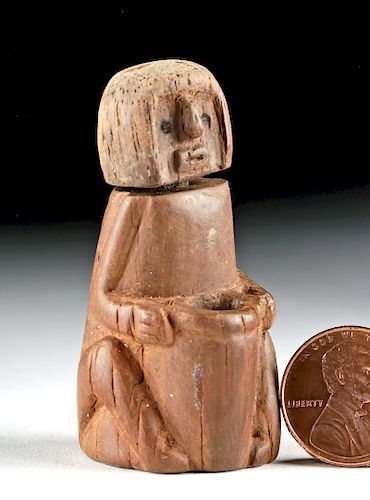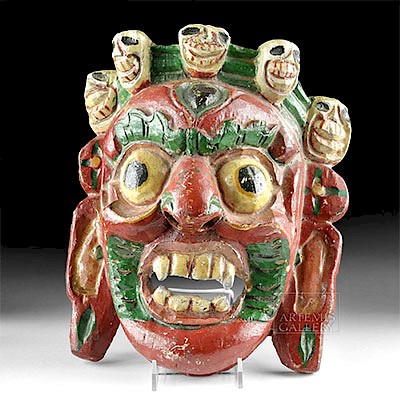Rare Huari Wooden Anthropomorphic Poporo
Lot 59
About Seller
Artemis Fine Arts
686 S Taylor Ave, Ste 106
Louisville, CO 80027
United States
Selling antiquities, ancient and ethnographic art online since 1993, Artemis Gallery specializes in Classical Antiquities (Egyptian, Greek, Roman, Near Eastern), Asian, Pre-Columbian, African / Tribal / Oceanographic art. Our extensive inventory includes pottery, stone, metal, wood, glass and textil...Read more
Estimate:
$1,000 - $1,500
Absentee vs Live bid
Two ways to bid:
- Leave a max absentee bid and the platform will bid on your behalf up to your maximum bid during the live auction.
- Bid live during the auction and your bids will be submitted real-time to the auctioneer.
Bid Increments
| Price | Bid Increment |
|---|---|
| $0 | $25 |
| $300 | $50 |
| $1,000 | $100 |
| $2,000 | $250 |
| $5,000 | $500 |
| $10,000 | $1,000 |
| $20,000 | $2,500 |
| $50,000 | $5,000 |
| $100,000 | $10,000 |
| $200,000 | $20,000 |
About Auction
By Artemis Fine Arts
Apr 25, 2019
Set Reminder
2019-04-25 10:00:00
2019-04-25 10:00:00
America/New_York
Bidsquare
Bidsquare : Pre-Columbian | Tribal | Ethnographic
https://www.bidsquare.com/auctions/artemis-gallery/pre-columbian-tribal-ethnographic-4035
Featuring ancient and ethnographic art from around the world, including Pre-Columbian, Native American, African / Tribal, Ethnographic, Spanish Colonial, Fossils, Fine Art, much more. Artemis Fine Arts info@artemisgallery.com
Featuring ancient and ethnographic art from around the world, including Pre-Columbian, Native American, African / Tribal, Ethnographic, Spanish Colonial, Fossils, Fine Art, much more. Artemis Fine Arts info@artemisgallery.com
- Lot Description
Pre-Columbian, South Coast Peru, Huari (Wari) culture, ca. 700 to 1000 CE. A rare example of a hand-carved wooden poporo with a deep interior cavity meant for containing lime powder. The vessel depicts a stylized anthropomorphic figure in a seated position, with sinuous legs wrapped around the base of a tall jar and arms grasping the rim. The removable head doubles as the vessel stopper and exhibits petite circular eyes, a bulbous nose, full lips, and a rounded coiffure draped over the top. Size (w/ lid): 1" W x 2.125" H (2.5 cm x 5.4 cm).
Poporos or lime containers were part of the ancients' coca-chewing implements. They were made from various materials - including shell, stone, wood, bone, ceramic, and gold - throughout the Andes of South America for thousands of years. Traditionally, the indigenous chewed coca by placing some leaves in the cheek and gradually adding powdered lime made from calcined shells from the poporo with a spoon like this example in order to enhance the stimulating effect. A poporo consists of two pieces: the receptacle and the lid which includes a pin that is used to carry the lime to the mouth while chewing coca leaves; this example does not include a pin. Since the chewing of coca is sacred for the indigenous people, poporos are also attributed with mystical powers and social status.
Provenance: private Hawaii, USA collection; ex-private Hans Juergen Westermann collection, Germany
All items legal to buy/sell under U.S. Statute covering cultural patrimony Code 2600, CHAPTER 14, and are guaranteed to be as described or your money back.
A Certificate of Authenticity will accompany all winning bids.
We ship worldwide and handle all shipping in-house for your convenience.
#143636Plug of lid reattached with light adhesive residue and earthen stabilization material along break line. Minor abrasions to body and head, small chip to top rim, with softening to some facial details, and a couple of stable fissures. Nice patina throughout. Old inventory label beneath base.Condition
- Shipping Info
-
All shipping is handled in-house for your convenience. Your invoice from Artemis Gallery will include shipping calculation instructions. If in doubt, please inquire BEFORE bidding for estimated shipping costs for individual items.
-
- Buyer's Premium



 EUR
EUR CAD
CAD AUD
AUD GBP
GBP MXN
MXN HKD
HKD CNY
CNY MYR
MYR SEK
SEK SGD
SGD CHF
CHF THB
THB















